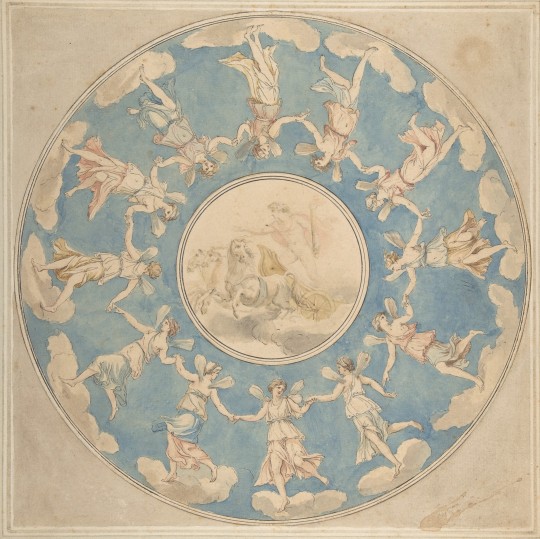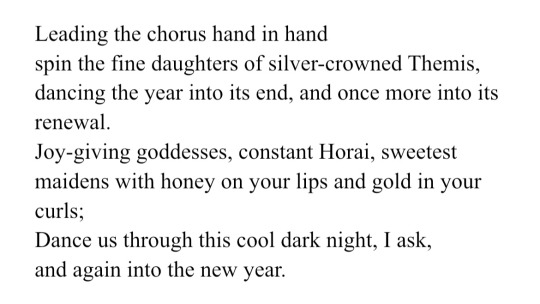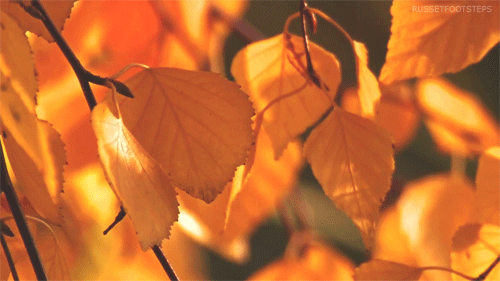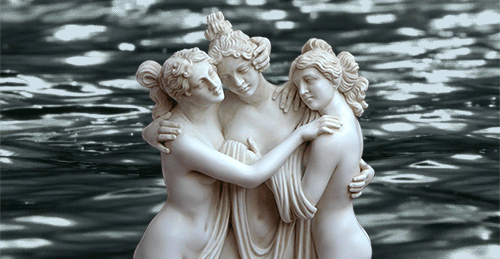#Horae
Explore tagged Tumblr posts
Text

Eirene and Dike
No Peace without Justice
#greek mythology#greek pantheon#Dike#eirene#greek goddess#Themis#Horae#goddess of justice#goddess of peace
1K notes
·
View notes
Text

Design for a Ceiling: Apollo and the Hours by Angelica Kauffmann
Swiss, 18th or early 19th century
black ink, gray ink, brown wash, and watercolor, over black chalk
Metropolitan Museum of Art
#neoclassicism#art#mythology#Apollo#Hours#Horae#Angelica Kauffmann#Angelica Kauffman#Swiss#watercolor#pen and ink#chalk#Metropolitan Museum of Art
666 notes
·
View notes
Text
Pyanepsia
~ 7 Pyanepsion ~
Pyanepsia celebrated Apollon and Theseus, connected to his Labours. When defeating the Minotaur, Theseus promised to honor Apollon if he could aid in defeating the Minotaur. Once he did, it is said Theseus established Pyanepsia. This celebration was continued on by Theseus' cult.

Apollon was seen as a giver of agriculture in this status, tied along to with Helios and the Horai, who were also worshipped this day. Both the divine law Horai and the seasonal Horai were celebrated.
The day centered around panspermia, a mixture of beans, wheat and seeds that was connected to Theseus. Public feasting would also be a large part of this day regarding the panspermia.
Young boys also proceeded eiresione, an olive branch bound in white/purple wool with seasonal fruit/honey jars/pastries hanging from it, during Pyanepsia. This represented the agricultural abundance of the day. The eiresione was said to be a thanks offering to the gods, along with a protection against evil in the future. The eiresione proceeded was the hung at the entrance of Apollon's temple with a chant. Smaller eiresiones would be left at households as well . The branch would then be replaced at next years Pyanepsia.

Pyanepsia was connected to Thargelia as another agricultural festival worshipping Apollon.
Traditional Offering:
Panspermia
Eiresione
Hymns to Apollon
Hymns to Helios
Hymns to Horai
Traditional Acts:
Procession to Apollons temple
Feasting
Celebration of Apollon
Celebration of Helios
Celebration of Horai
#hellenic worship#hellenism#hellenic polytheistic#hellenic deities#hellenistic#theoi#hellenic polytheism#hellenic witch#helpol#apollo deity#lord apollo#apollo#apollon deity#apollo worship#apollon#apollon worship#lord apollon#lord helios#horai#horae
20 notes
·
View notes
Text

The Birth of Venus by Sandro Botticelli
#sandro botticelli#art#birth#venus#renaissance#florence#uffizi#italy#europe#european#italian#classical mythology#gods#mythology#mythological#zephyrus#aura#horae#godesses#zephyr#chloris#greek mythology#roman mythology#goddess#shell#cloak#wings
407 notes
·
View notes
Text
Hello once more! Thank you all so much for your love on Aphrodite's infe sheet, I am beyond happy so many of you enjoyed it!
Anyways, today's post is an info sheet on Eirene. It was a tricky one since not much info is out there on her. From reading excerpts, I realized she is also as much of a goddess of peace as she is of prosperity and wealth, since, specially in ancient times, peace brought about both to society.
About the epithets, except for "Hora Thallo" all others aren't exactly specific to her, some are used for multiple gods & goddesses, some customary to only one deity, but these are the ones whose meaning I found fitted the goddess.
Some devotions were taken out of blogs on how to keep and spread peace, also on day-to-day life.
I found no hymn for Eirene, but I found a beautiful prayer that I included in the hymn's place.
Thank you all so much once again, see you all soon!

#deity work#hellenic pagan#hellenic polytheism#hellenism#pagan#paganism#hellenic deities#greek gods#info sheet#eirene#horae#goddess#peace#pax#goddess of peace
31 notes
·
View notes
Text

(1 January 2024)
67 notes
·
View notes
Text

August 21, 2024:
Orange Primary, Pearlcatcher, Noxtide.
Horae of Shika's clan!
13 notes
·
View notes
Text







Some of the Horae and goddesses of the seasons and justice.
2 notes
·
View notes
Text
Karpo Deity Guide

Who is Karpo?
Seen as somewhat of a minor deity in mythos, Karpo (Καρπω) , also written as Carpo, is the Greek goddess or one of the Horae—goddesses of the seasons—representing Autumn and harvest. The ancients had varying ideas of the seasons and these ideas would change depending on where, when, and who you asked.
In some places, there were three seasons, and so there were three Horae. In other places, there were only two, and in others, there were four or five.
Despite being a minor deity in mythology, Karpo (along with the other Horae) had some big jobs to do. Horae were in charge of guarding Olympus, helping Helios, protecting young humans and newborn gods, as well as running the passage of time and ripening fruit!
Parents and Siblings
For parentage, there are two main pairings I’ve found:
Zeus and Themis (Hesiod)
Helios and Selene (Later in Roman myth)
For siblings the list could go on forever, as this list would change depending on the parents. Instead, I’ll list the other Horae:
Auxo
Thallo
(Originally the three seasons’ goddesses were the Auxo, Thallo, and Carpo. Later other Horae were added)
Lovers or Partners
None listed
Children
None listed
Epithets
Phthinoporon (a later iteration of the goddess of Autumn, who some say is the same as Karpo)
The Bringer of Food/Fruits
Damia (possibly)
Notes
Karpo comes from the Greek Karpos meaning “fruit” but her name could also mean “harvest” in the context of the Horae.
The Horae were mostly worshipped by farmers.
It’s possible the name Karpo started as an epithet of Demeter.
Karpo is also described as also having been a Charity by Pausanias
I have found one mention of a festival—Horaea, with no date or timeframe given.
The Horae were often found in the company of Aphrodite, the Muses, and Apollo.
Karpo specifically has been associated with Dionysus, Persephone, Hera, and Pan.
In early Athens, only Karpo and Thallo were worshipped. They were also worshipped at Argos, Corinth, and Olympia.
The Horae are also seen as protectresses of newborn gods and of youths and as such were mentioned in the oaths that Athenian youths would make in the temple of Agraulos
They are depicted as young maidens, often dressed lightly and covered in flowers. The Horae are pleasant and kind towards humans, neutral at worst.
Modern Deity Work
Not much is known about how the Horae were worshipped, so I have done my best to find some traditional offerings and correspondences as well as modern ones.
Correspondences
Rocks/Stone/Crystals
Gold, Carnelian
Herbs/Plants
Grapes
Most fruits but especially those from Ancient Greece such as pomegranates, raisins, and figs.
Olives
Animals
Hare
Lizard
Offerings
Wine
Grapes
Olives, olive oil
Flowers (+ flower garlands, flower crowns)
Honey
Jewelry
Acts of Devotion
Work in a garden or tend to plants
Appreciate the passage of time
Celebrate annual festivals or holidays related to the passage of time
References and Further Reading
History Cooperative - Horae
Theoi Project - Karpo
Theoi Project - Horai
Ancient-greece.org - Horae
World History - Horae
Hellenica World - Horae
30 notes
·
View notes
Text
New Demigod Cabin: The Horae (Seasons)






Greek mythology refers to multiple groups as Horae, a name associated with the passage of time. The main triad consists of Thallo or Thalatte(Spring), Auxo or Auxesia (Summer), and Carpo (Autumn). As goddesses of the seasons they are closely associated with agriculture and often accompany Persephone. The Horae are also associated with flowers and beauty and in ancient times were sometimes conflated with the Charites. Both groups are part of the retinue of Aphrodite, who is described as wearing clothes made by them. In art, the Horae are often joined by Chione, the snow goddess daughter of Boreas (god of the cold north wind) and Orithyia (mountain winds), who represents winter. The Horae's cabin is essentially three connected cabins radiating from a small atrium. Each section is themed around a specific season, and the room temperatures are all separate and don't mingle. There are lots of scented candles and sticks of incense with smells associated with the different seasons. In the atrium are an ice-cream cooler and snack bin filled with goodies that are limited-time seasonal flavors like pumpkin, peppermint, and smores. In fights demigod children of the Horae can use nature and the air around them to induce a strong allergy attack, making it difficult for their opponents to focus and coordinate. The more dust and pollen there are in the air, the stronger the attack is. A Horae demigod's powers are also amplified during the season their mother is associated with. But seasons are determined by the sun and its position in relation to earth, so these demigods are weakest during the night, in the underground, or indoors with no natural light. Historical Demigods/Legacies Thallo: Antonio Vivaldi, Rachel Carson Auxo: Spyridon Louis, Cleveland Abbe, Calvin Coolidge Carpo: Bela Lugosi, Stepheno Martinelli Cabin Members Thallo: April Lush, Eva Springer, Vernon Mayfield Auxo: Rosalia Bolivar, June and Austin Summers Carpo: Sadie Akiyama, Ash and Oakley Erikson Head Counselor: Augustin Verano
#camp half blood#percy jackon and the olympians#percy jackson cabins#percy jackson fanfiction#percy jackson new cabins#pjo#pjo aesthetic#pjo cabins#pjo fanfiction#pjo moodboard#horae#carp#auxo#thallo#auxesia#thalatte#seasons
6 notes
·
View notes
Text

Casi un alebrije.
3 notes
·
View notes
Text
It is implied on theoi.com that Hera was involved with "the mid-wifery of the Kharites and the nursing of the Horai" according to Alkaios (it is listed among other sources where Hera is or could be mother of the Charites), but does anyone know if he actually said that? All I've been able to find is this: "But since this literary form is found among the ancients, and some ere this have sung of the birth of Dionysus and others of the birth of Apollo, and Alcaeus of that of Hephaestus also and again of that of Hermes, I have made it a separate class…. The form is useful only to the poet, never to the prose-writer; for the one deals with the midwifery of the Graces and the nursing of the Seasons and the like, whereas the other will of necessity express himself as briefly as possible." (Menander, Declamations [on genealogic hymns). No mention of Hera here.
I'm aware that Hera is on rare occasion called mother of the Charites in later sources, the Horai were apparently her nurses according to Olen, both the Horai and the Charites were depicted on the crown of her famous Argive statue, her name and the word ὥρα might be etymologically linked, statues of the Horai were placed next to the statue of Hera in the Heraion at Olympia, and the Horai can appear as her handmaidens. So the connection between them definitely exists, but does Alkaios actually mention it or is theoi misleading me? That's what I'd like to know.
3 notes
·
View notes
Text
Sun In Taurus II - the Horae
The Horae, or 'seasons', rule the next ten days starting tomorrow at 10:35 am EDT — However you think about time, whether in days or weeks or hours... lengthen your perspective; consider who you want to be when autumn comes... #astrology #decans #taurusII
The Sun enters Taurus II The Lingam Yoni, on April 30, 2023 at 10:35 am EDT — the region of the sky that the Hellenistic era associated with the Horae or “hours”, the spirits of the seasons and the changes of time that bring about shifting weather conditions from snow to rain to sun; shifts in plant behavior, from leaf to flower to fruit; and shifts in animal behavior from shelter to adventure.…

View On WordPress
#"the Hours"#astrology#Horae#Lingam-Yoni#Taurus#taurus II#Taurus II 2023#the Horae#The Moon
3 notes
·
View notes
Text
Horae
Horae (or Horai) are the seasons of Hellenism. They are often seen as a group of three goddesses, however in reality there are many variations on which goddesses they are, or even if they are epithets of each other.

Most commonly the three Seasons are seen as Dike (personification and goddess of divine justice), Eunomia (goddess of good order and lawful conduct), and Eirene (goddess of peace). This, however, is their later interpretation. Slowly across the Classical and Hellenistic Periods the Horae changed from season deities to goddesses of order and justice.
So while Lady Dike, Lady Eunomia and Lady Eirene are correctly the Horae, they are also correctly Thallo (goddess of "green-shoots" and blooming), Auxo (goddess of vegetation and growth at full bloom), and Karpo (goddess of ripening plants and fruits of the earth).
It's good to note that each Goddess here is also a Daimon, a personification, of their respected rulings. For example, you may find confusion while speaking of Karpo as the personification of Autumn, due to her also being the goddess of ripe fruit. This could easily be meshed in one's mind with Lady Demeter, goddess of the Harvest, who is commonly associated with autumn. However, Lady Demeter is not a personification, and is an Olympian Deity, marking her vastly different from Lady Karpo as the Daimon and Goddess of Autumn itself.

In the Iliad, the Horae were keepers of Zeus's gate on Olympus. This is thought to be their earliest written record. Here the Horae were said to be born of Zeus and Themis, meaning they would be the later goddesses.
Primarily, the earlier variation of the goddesses were worshipped in rural Greece. The later were also adopted in rural areas, but less as nature deities and more of goddesses that represent farming prosperity. The earlier goddesses are often seen with Chione (goddess of snow) and Orithyia (goddess of cold mountain winds). Together, Thallo, Auxo, Karpo, Chione and Orithyia were seen as handmaidens/entourage to Persephone as the goddess of the turn of seasons.
Nonnus described the Horae as four daimons, the daughters of Helios (And sometimes Selene) and handmaidens of Queen Hera. These daimons are different from the previous group due to them not only being seen occasionally as winged children, but also being not goddesses but personifications. These daimons are Eiar (personification of spring), Theros (personification of summer), Phthinoporon (personification of autumn), and Cheimon (personification of winter). However, this variation of the Horae are from a Greek poet living in Imperial Rome, so take it with a very large grain of salt as a Hellenist. But if you worship the Roman pantheon, you might want to look more into this variation than others!

Personally, as a Hellenist myself, I look more towards the first two variations of the Horae. Not one is wrong in their claim to their sisterhood of the Horae. With Cronus's wheel of time comes change, and it is only natural for it change as such. I worship both trios (and Chione + Orithyia) as the Horae, because they both are! They are goddesses of time in their own respect, and all eight deserve reverence, worship, and devotion as goddesses that aid us in every turn of life.
HELPFUL LINKS:
#hellenic polytheism#hellenic witch#hellenism#hellenic deities#hellenic polytheistic#hellenic worship#hellenistic#horae#horai#Eirene goddess#Dike goddess
8 notes
·
View notes
Photo

Horas
Las Horas (Horai, singular Hora) eran las personificaciones y las diosas de las estaciones y de las horas y posteriormente, fueron consideradas como las diosas del orden y de la justicia en la mitología griega. Eran las hijas de Zeus y de la titánide Temis y solían ser tres. Sin embargo, sus nombres y su número difieren dependiendo de la fuente.
Sigue leyendo...
0 notes